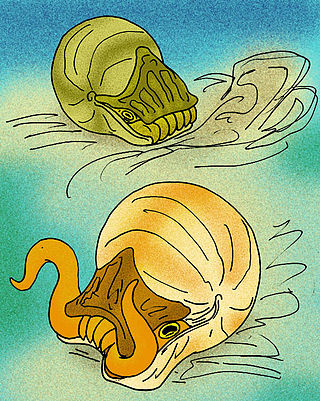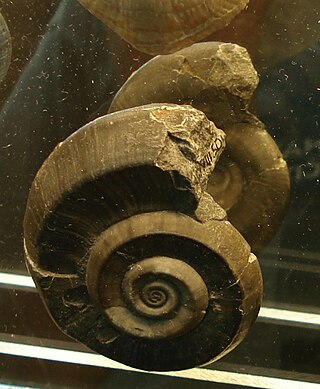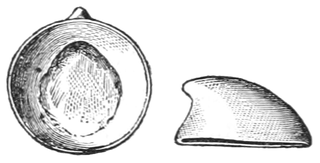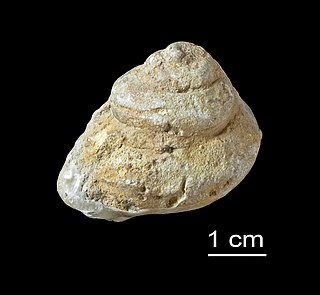Related Research Articles

Meniscoessus is a genus of extinct multituberculates from the Upper Cretaceous Period that lived in North America.
Drahomira is an extinct genus of paleozoic monoplacophorans in the family Tryblidiidae.

Ammonoceratites is an extinct genus of ammonoid cephalopod known from the Albian of British Columbia, Madagascar, New Zealand, and Japan, included in the Lytoceratidae.

Arcestes is a genus of extinct ceratitid ammonites found in Triassic-aged marine strata.

Euomphalidae is an extinct family of Paleozoic to early Mesozoic marine molluscs which may be gastropods with anisostrophically coiled shells . The shells show a selenizone.

†Archinacellidae is an extinct family of paleozoic molluscs of uncertain position.
The Anomphalidae is an extinct family of fossil sea snails, marine gastropod mollusks. These are archaeogastropods which are included in the suborder Trochina. The Anomphalidae lived during the Paleozoic, from the Silurian to the Middle Permian. According to some authorities these snails belong instead to the Euomphalacea.

†Holopeidae is an extinct family of paleozoic gastropod mollusks. These molluscs were stationary epifaunal suspension feeders.
Isospiridae is an extinct family of fossil sea snails, Paleozoic gastropod mollusks.

Pilina is an extinct genus of paleozoic monoplacophorans in the family Tryblidiidae.
The Ulan Malgait Formation is a Late Jurassic geologic formation in Mongolia. Dinosaur remains are among the fossils that have been recovered from the formation, although as of 2004 none have yet been referred to a specific genus.

Acanthoceratoidea, formerly Acanthocerataceae, is a superfamily of Upper Cretaceous ammonoid cephalopods belonging to the order Ammonitida, and comprising some 10 or so families.
Neolissoceras is a genus of haploceratid ammonites with a smooth, compressed, flat-sided shell with a flatly rounded venter and distinct umbilical margin, from the Upper Jurassic (Tithonian) - Lower Cretaceous (Hauterivian) of southern Europe, Madagascar, and India.
Amphiscapha is a fossil gastropod mollusk, or less likely a monoplacophoran, genus from the Pennsylvanian and Lower Permian of North and South America, included in the family Euomphalidae. It is sometimes regarded as a subgenus of Straparollus, S. (Amphiscapha) Knight 1942
Bochianites is a straight shelled ammonite which lived from the Upper Jurassic, Tithonian, to the Lower Cretaceous, Hauterivian in what is now Europe, Greenland, Africa, North America and Asia. The shell is long, narrow, moderately expanding; smooth or with weak to strong oblique annular ribs. Sutural elements are short and boxy. The umbilical lobe, which lies between the lateral lobe and dorsal lobe, on either side, is about the same size as the lobule dividing the first lateral saddle.
Prochelidella is an extinct genus of Early to Late Cretaceous chelid turtles from the Bajo Barreal, Candeleros, Cerro Barcino and Portezuelo Formations of the Cañadón Asfalto, Golfo San Jorge and Neuquén Basins in Patagonia, Argentina. It includes the following species:
Praenuculinae is an extinct subfamily of prehistoric bivalves in the family Praenuculidae. Praenuculinae species lived from the middle Ordovician through the late Devonian. Praenuculinae fossils are found in Europe, Africa, North America and South America, and species are thought to have been stationary attached to substrate in shallow infaunal marine water environments where they formed shells of an aragonite composition. The subfamily Praenuculinae was named by Teresa M. Sánchez in 1999.

Holopea is an extinct genus of fossil sea snails, Paleozoic gastropod mollusks in the family Holopeidae.

Tubospirina is an extinct genus of fossil sea snails, marine gastropod mollusks in the family Craspedostomatidae. These snails were parasitic-carnivores. They lived in the Silurian Period, Pridoli Age.
Craniopsidae is an extinct family of craniiform brachiopods which lived from the mid-Cambrian to the Lower Carboniferous (Tournaisian). It is the only family in the monotypic superfamily Craniopsoidea and the monotypic order Craniopsida. If one includes the ambiguous Cambrian genus Discinopsis, craniopsids were the first craniiforms to appear, and may be ancestral to craniids and trimerellides. An even earlier Cambrian genus, Heliomedusa, has sometimes been identified as a craniopsid. More recently, Heliomedusa has been considered a stem-group brachiopod related to Mickwitzia.